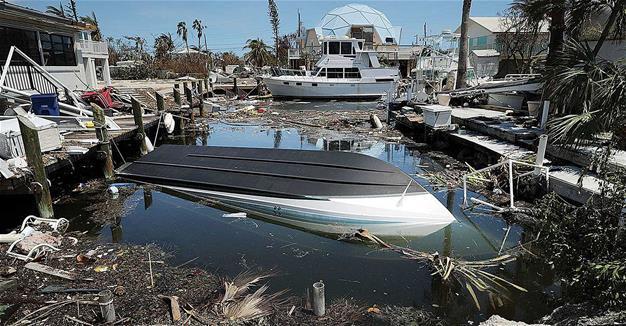Shocked residents return to Irma-ravaged Florida Keys
ISLAMORADA – Reuters
 Evacuees from Hurricane Irma were returning on Sept. 13 to the Florida Keys, where sunrise will give them a first glimpse of devastation that has left countless homes and businesses in ruins.
Evacuees from Hurricane Irma were returning on Sept. 13 to the Florida Keys, where sunrise will give them a first glimpse of devastation that has left countless homes and businesses in ruins.Categorized as one of the most powerful Atlantic storms on record, Irma claimed more than 60 lives, officials said.
At least 18 people died in Florida and destruction was widespread in the Keys, where Irma made initial U.S. landfall on Sept. 10 to become the second major hurricane to strike the mainland this season.
A resort island chain that stretches from the tip of the state into the Gulf of Mexico, the Keys is connected by a bridges and causeways along a narrow route of nearly 160 kilometers.
The Keys had been largely evacuated by the time Irma barreled ashore as a Category 4 hurricane with sustained winds of up to 215 km/hour.
Initial damage assessments found 25 percent of homes there were destroyed and 65 percent suffered major damage, Federal Emergency Management Agency administrator Brock Long said.
Authorities allowed re-entry to the islands of Key Largo, Tavernier and Islamorada for residents and business owners on Sept. 12. The extent of the devastation took many of the first returnees by surprise.
A boil water notice was in effect for the Keys late on Sept. 12, while its airports remained closed to commercial flights.
Several major airports in Florida that had halted passenger operations resumed with limited service on Sept. 21, including Miami International, one of the busiest in the United States.
All 42 bridges in Monroe County, which includes the Keys, were deemed safe and one of two washed out sections of U.S. 1 Roadway was now navigable, the county said on its Twitter account.
At the end of Islamorada, roughly the halfway point of the Keys, police at a checkpoint turned around returning residents seeking to travel farther south and waved through utility crews, law enforcement and healthcare workers.
Authorities said they were barring re-entry to the remainder of the Keys to allow more time to restore electricity, water, fuel and medical service. U.S. officials have said some 10,000 Keys residents stayed put when the storm hit and may ultimately need to be evacuated.
Across Florida and nearby states, some 5.8 million homes and businesses were estimated late on Sept. 12 to be still without power, down from a peak of 7.4 million on Sept. 11.
Florida’s largest utility, Florida Power Light Co , said western parts of Florida might be without electricity until Sept. 22.
The state’s largest city, Jacksonville, in its northeastern corner, was still recovering from heavy flooding on Wednesday.
While damage across Florida was severe, it paled in comparison with devastation wrought by Irma in parts of the Caribbean, which accounted for the bulk of the hurricane’s fatalities.
It destroyed about one-third of the buildings on the Dutch-governed portion of the eastern Caribbean island of St. Martin, the Dutch Red Cross said on Sept. 12.
Irma was a post-tropical cyclone late on Tuesday as it drifted north as it brought rain to the Mississippi Valley, the National Hurricane Center said.
It hit the United States soon after Hurricane Harvey, which plowed into Houston late last month, killing about 60 and causing some $180 billion in damage, mostly from flooding.
















